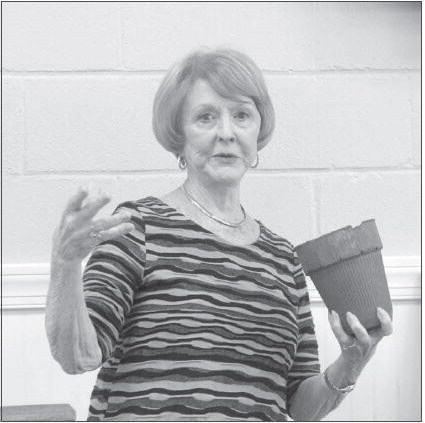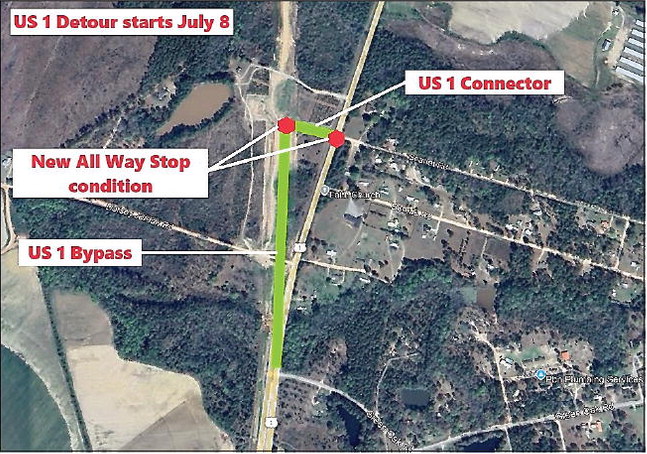Johnson Shares History of the Area


mrandolphadvance@gmail.com
The local chapter of the Daughters of the American Revolution (DAR) met for their monthly meeting on Wednesday, April 12, where member Sue Johnson provided attendees with a general history of Vidalia’s surrounding areas. According to Johnson, the information and stories shared come from family tradition, as generations passed on the tales orally throughout the years. She began by relating that although British General James Edward Oglethorpe founded the colony of Georgia in 1733, the region did not become substantially inhabited by Europeans until several years later.
“If we could take a giant step back into that particular time and visit our area, we would find out that it was [American] Indians living in the area [rather than any settlers] – those were our first residents in this area,” Johnson explained.
She said that settlers later came to the area after the American Revolutionary War, when land grants were given to individuals eager to own a piece of the New World. “You could claim your land grant and travel to the area to your new property,” Johnson emphasized.
One of the earliest settlers who traveled to the area to claim his land grant was former Revolutionary Soldier Lieutenant Lewis Hall, who has been the revolutionary ancestral connection needed to join the Daughters of the American Revolution for at least 15 members, including two of the inaugural members to the local chapter of the organization. “Now, Lewis happened to be my greatgreat- great- grandfather. He was also an ancestor to many other people in the area,” John told the attendees. “When Lewis got here to claim his land, he opened up a trading post on the river. He became an Indian Agent, and befriended the Indians. It is said that when he died, some of the Indians were actually his pallbearers.”
Hall soon became the owner of a large amount of land. “That was not hard to do back in those days – you had land grants and land lotteries,” she commented. “You bought a ticket to the land lottery and you may draw some land, or you may draw a blank, but through the years, you could increase your holdings through the land lottery or by coming up with the money to pay $0.25/acre.”
Johnson continued, “When it came time for a courthouse to be built over in Mount Vernon, Lewis donated some of his land for the courthouse.”
The City of Ailey
According to Johnson, the name of the city of Ailey also came from the early settlers, specifically an early settler named Ala Peterson.
Peterson was a part of the first wave of settlers, who were from the Scottish Highlands, to join the area. “Actually, two-thirds of all the pioneers here in those early years were of Scottish ancestry,” Johnson said. “Most of their relatives had lived in the Highlands of Scotland – the wild part of Scotland – and when some political upheaval happened in the 1700s, they left the Highlands of Scotland and moved over to the Cape Fear area of North Carolina.”
Johnson said she was unsure why the population chose the Cape Fear area, but the group shifted again in the 19th century, when many individuals gained land in the local area through the land lottery. Because of the large number of the population with Scottish Heritage, the Gaelic language was often spoken in Vidalia and the surrounding areas, and a church in Mount Vernon even offered an entire service spoken in Gaelic until the late 1880s.
Three of these Scottish ancestors were Hugh Mc-Natt, and his sisters, Ann and Ala. Ala’s in-laws, the Petersons, lived in a little settlement around 11 miles west of Vidalia. “When the railroad was coming through, Mr. Peterson said, ‘Well, I’ll be glad to donate some land for the depot, but there’s a stipulation: you’ve got to name the little town for my wife Ala,’” Johnson explained.
Leaders agreed to this stipulation, but when the name was submitted to the U.S. Postal Service, it was deemed too confusing because of the practice of using three letters to abbreviate states – back then, ALA stood for Alabama. Thus, Peterson suggested that the town be named the Gaelic translation of Ala’s name: “Ailey.”
Turpentine
According to Johnson, the second wave of settlers to the local area came through the rise of the turpentine business. This wave brought a lot of diversity, as many laborers were needed in the collection and creation of turpentine.
“There were a lot of families around here dealing in turpentine – it was a big industry,” she emphasized.
Many of these settlers brought dogs with them to their new home, which disrupted the sheepherding business that many Scottish immigrants were still active in through markets in Darien. “Sheep and dogs generally don’t mix very well. Also, a lot of the sheep would rub up to trees – that sap would get in their wool and be impossible to get out,” Johnson noted. “Thus, the birth of the turpentine industry was the death of the sheepherders.”
Lumber Barons
Soon, the profitability of timber was discovered, which made the quest for and value of land even higher.
“People realized they could make a lot of money if they cut their trees and sold them, so they began doing that,” Johnson told the group. “You’ve probably heard stories about people cutting and tying trees together and floating them down the river to Darien.”
And the value of timber brought the rise of the “lumber barons,” who were wealthy men seeking land with timber. Among these “lumber barons” was the Georgia Land and Lumber Company, which was founded by the men which Dodge County and Eastman are named after. The company bought over 300,000 acres of land filled with longleaf pine trees.
“They paid around $0.10 per acre for all this land, but on top of that, they evicted over 400 local farmers that had been living on that land,” she said about the company. “They came in and told the farmers, ‘This land you’ve been living on, you think you own it, but you don’t. You don’t have a clear title to this land, so you’re going to have to leave.’ The farmers had to pick up and leave their homes.”
Johnson said that many lawsuits were filed by farmers attempting to save their homes, but the federal government sided with the company. “There was nothing they [the farmers] could do. There were court cases, there were imprisonments, there was an assassination, there were 5 decades of feuds and murders because nothing was done about this land,” she added.
This chaos ended in 1953, when some of the original landowners regained their barren land. “It was said to look like a war zone when [the original landowners] got their property back. In some areas, as far as you could see, there was nothing but tree stumps where the longleaf pines were destroyed,” she concluded.
Moody Forest
The last bit of history that Johnson shared dealt with Moody Forest, a wildlife management area in Appling County.
In the 1800s, the Moody family came to claim their land grant, which gave them land right across the Altamaha River. “Over time, the Moodys were able to gain over 4,000 acres of wilderness – this included virgin longleaf pines, some of which were over 300 years old,” she explained.
Johnson continued, “They were great stewards of this wilderness. The last two family members to live there were two brothers who lived in what really looked like a shack. They had taken newspapers and placed them around the interior walls to keep the drafts out. People wanted to buy their land all the time for the timber, but they refused to sell. They were basically living in poverty while sitting on a goldmine.” In 2000, the brothers died, and the land passed to 32 relatives of the original landowners. “These relatives were bombarded with offers to sell their land or to cut their timber, but they wouldn’t do that,” she continued. “They decided to accept sealed offers within a timeframe to sell the land. When that day came and the bids were read, an actual miracle happened: the top bid went to a partnership between the Nature Conservatory and Georgia Department of Natural Resources.”
Currently, those two agencies work together to manager the nature preserve and a 5-mile nature trail. The land is cared for by Department of Natural Resource rangers who carry out controlled burnings and work to protect the endangered species of wildlife that live within the forest.
Conclusion
Johnson concluded her address by explaining how it was important to remember the past, which is a principle which the Daughters of the American Revolution (DAR) are founded upon.





